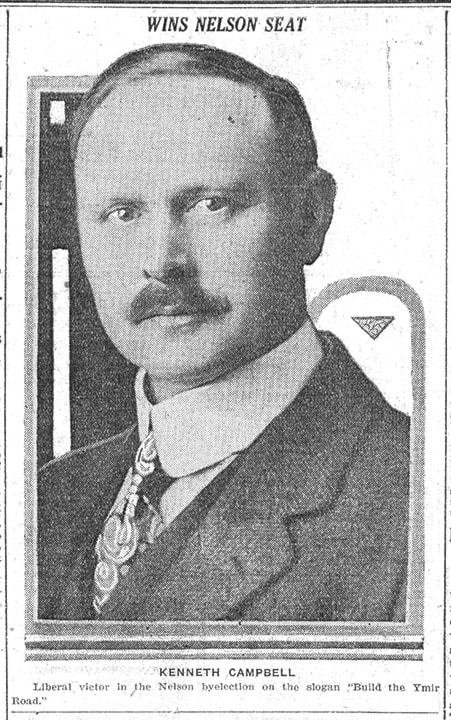Some further digging in the archives produced more details about Kenneth Campbell, who stepped aside so Premier John Oliver could run for office in Nelson in 1924, as detailed in this space Friday (“Nelson gets a shot at electing a premier.”)
Campbell was born around 1881 at Galterigill, Duirnish, Isle of Skye. He did business in Glasgow for five years, went to New Zealand and Australia for five years, and returned to Scotland to marry.
He arrived in Nelson in 1910, ran a hotel in Sandon for three years, and then came back to Nelson to buy out the Kootenay Monumental Co. with fellow Scotsman A.G. Ritchie.
Campbell lived in Fairview with his wife and four children. He was a founder of the Kootenay Kiltie pipe band, belonged to the board of trade, served as a school trustee, and in 1922 topped the polls for city council. Soon afterward he defeated several others for the Liberal nomination in the Nelson riding.
I wrongly stated Charles F. McHardy was Nelson’s former mayor when he ran against Campbell in that byelection. In fact, he was the sitting mayor — and therefore the vote pitted council colleagues against each other.
I still don’t know what became of Campbell after 1927.
FIRE SALE: In another story Friday (“Horses, hoses, and history”) I wrote the Nelson fire hall came in under budget and slightly behind schedule. But it was more like slightly over budget and well behind schedule.
According to the Nelson Daily News of August 27, 1912, while the contract was awarded to John Burns and Son for $17,973 the overall cost was closer to $21,000 when factoring in $1,100 to acquire the property and $1,700 for a new alarm system. Council originally budgeted $20,000 for the project, which was expected to be finished around the end of November, but took until May due to boiler problems.
I also neglected to point out that the fire hall’s construction was probably hastened by the fire bug of 1911-12, about which more in a subsequent story.
CAPITOL MEMORIES: Mitzi Hufty phoned to say that while the Capitol Theatre ceased to be a regular moviehouse as of 1947, it did continue to show movies whenever the Civic hosted a live show.
Hufty, who worked at the Civic from about 1948 to 1953, recalled on those occasions they packed up the concession and moved over to the Capitol. In those days Cecil Hughes managed both theatres.
“I remember we used to be very excited about it,” Hufty says. “It didn’t happen that often.”
Indeed, I found an ad in the Daily News of September 28, 1951 for Fort Worth at the Capitol, starring Randolph Scott.
Hufty says in those days, a decade before it was all but abandoned, the Capitol was “gorgeous ... The [Ward Street] entrance was something. It had a glass ticket booth. You went through beautiful old velvet curtains into the theatre.”
I erred in saying the Capitol screened the Lon Chaney film Mr. Wu a few days before its grand opening in 1927 (“Ten things you [probably] didn’t know about the Capitol Theatre,” May 8). A closer inspection of the ad on which I based that statement shows the film actually appeared at the Starland Theatre on Baker Street, which was also part of the Capitol circuit and closed upon the new theatre’s opening.
